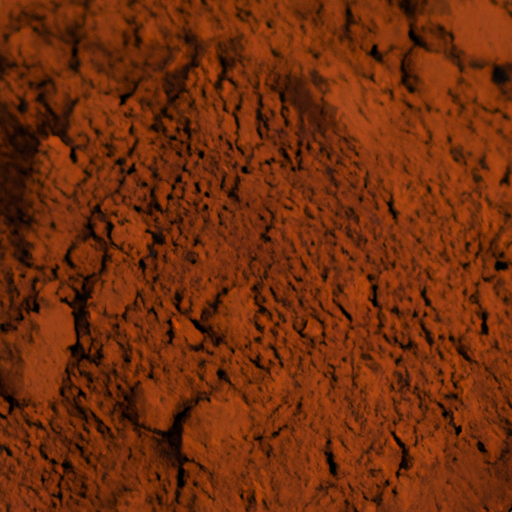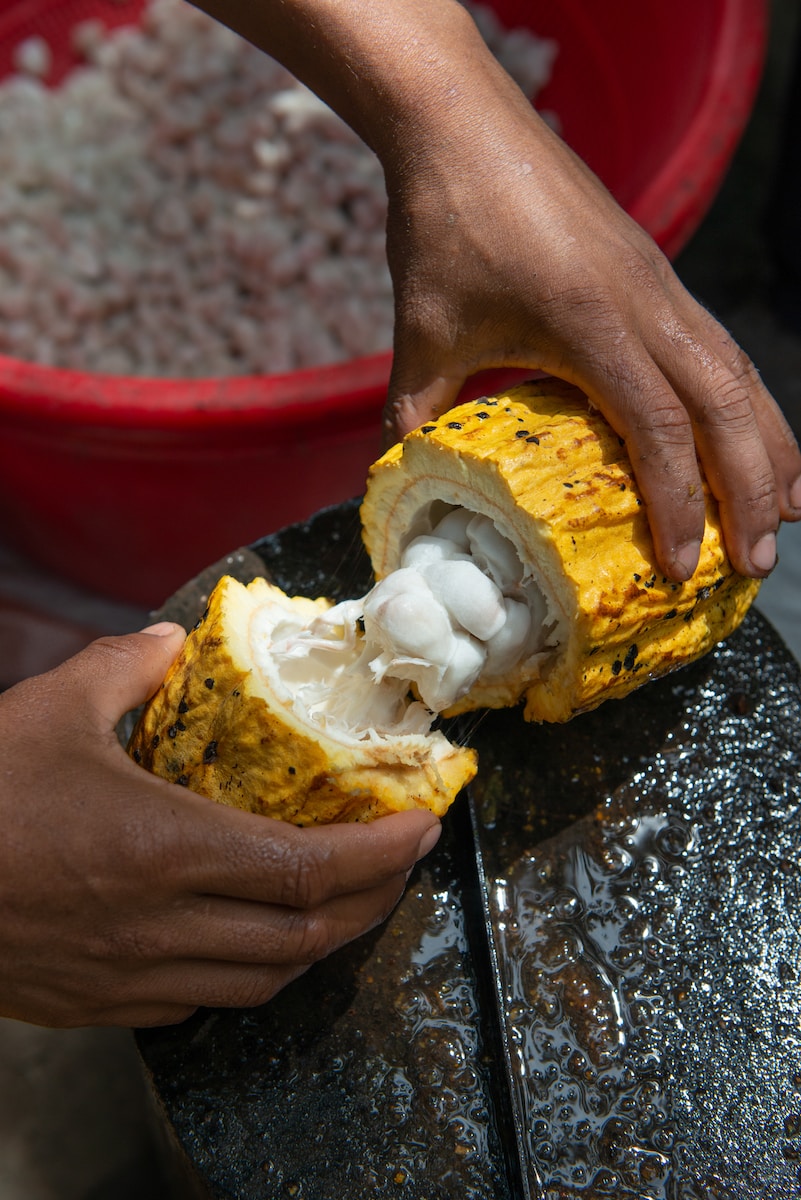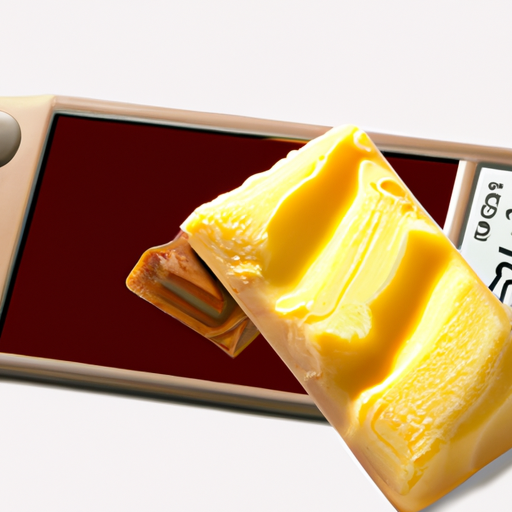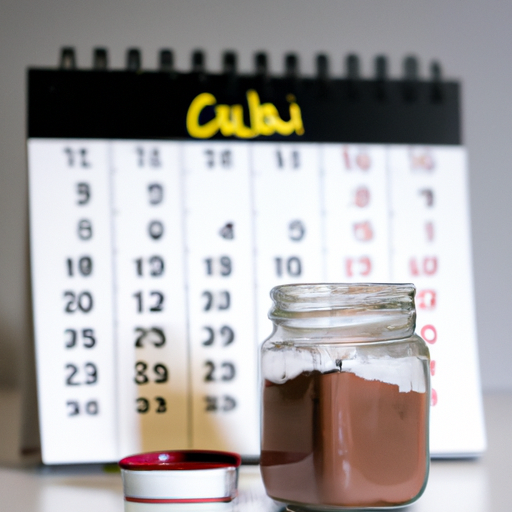Have you ever pondered the taste of raw cacao powder? Get ready for a unique flavor experience.
Picture this: your taste buds dancing with delight as they encounter the rich, velvety notes of chocolate, intertwined with hints of bitterness and a subtle touch of sweetness. It’s a symphony of flavors that stimulates your senses and leaves you craving more.
As someone who has explored the world of raw cacao powder, I can assure you that its taste is truly unique and captivating. But it doesn’t stop there.
Raw cacao powder also boasts an impressive range of health benefits, making it a guilt-free indulgence. Whether you’re a culinary enthusiast or simply curious about new flavors, join me as we dive into the mesmerizing world of raw cacao powder and unlock its secrets.
Get ready to redefine your chocolate experience.
Key Takeaways
- Raw cacao powder has a strong and bitter taste compared to cocoa powder.
- It has a rich, intense flavor with hints of fruitiness and earthy undertones.
- The bitterness can be balanced with other ingredients and preparation techniques.
- When substituting raw cacao powder, measurements and ratios should be adjusted, and more liquid may be needed due to its drier texture.
The Origins of Raw Cacao Powder
Raw cacao powder has a fascinating history of origins. The history of cacao cultivation dates back thousands of years, with its roots in ancient Mesoamerica. The Mayans and Aztecs were the first to discover the cultural significance of cacao, considering it a sacred and precious ingredient. It was believed to have divine qualities and was often used in religious ceremonies and rituals.
Cacao was even used as currency in some civilizations, highlighting its immense value. The cultivation of cacao eventually spread to Europe during the colonial era, where it gained popularity as a luxurious commodity. This rich and storied history adds to the allure of raw cacao powder.
Now let’s explore the rich and intense flavor profile that makes it so unique.
The Rich and Intense Flavor Profile
When it comes to the flavor profile of raw cacao powder, there are two key points that stand out to me:
-
The notes of chocolate and bitterness: The taste of raw cacao powder is rich with a deep chocolate flavor, but it also has a slight bitterness that adds complexity to its taste.
-
Earthy and nutty undertones: In addition, there are subtle earthy and nutty undertones that give the powder a unique and distinct character.
Overall, the flavor of raw cacao powder is intense and indulgent, making it a delight for chocolate lovers like myself.
Notes of chocolate and bitterness
With its rich notes of chocolate and a hint of bitterness, raw cacao powder transports your taste buds to a decadent, dark chocolate paradise. The bitterness in raw cacao powder comes from natural compounds like theobromine and flavonoids, which add depth and complexity to its flavor profile.
It’s fascinating to explore the science behind this bitterness and how it interacts with our taste receptors. To balance out the bitterness, you can add natural sweeteners like honey, maple syrup, or coconut sugar. These options enhance the sweetness without overpowering the rich chocolate taste.
As you savor a spoonful of raw cacao powder, you’ll also notice earthy and nutty undertones that add a delightful contrast to the chocolatey richness. These nuances create a harmonious symphony of flavors that make raw cacao powder a true gourmet experience.
Earthy and nutty undertones
Indulge in the delightful duet of earthy and nutty undertones that dance on your taste buds when you savor a spoonful of raw cacao powder. The earthiness of this superfood adds a unique depth to its flavor profile, making it a true treat for the senses.
Here are four reasons why the earthiness of raw cacao powder is worth exploring:
-
Complexity: The earthy undertones in raw cacao powder create a complex flavor experience that goes beyond the sweetness of regular chocolate.
-
Authenticity: The distinct earthiness of raw cacao powder is a testament to its unprocessed nature, providing a more authentic taste compared to processed cocoa.
-
Balance: The earthiness perfectly balances the natural bitterness of cacao, resulting in a rich and satisfying flavor.
-
Pairing Potential: The nutty undertones in raw cacao powder make it a versatile ingredient that pairs well with a variety of flavors, enhancing both sweet and savory dishes.
As you savor the earthiness and flavor notes of raw cacao powder, you’ll also reap its numerous health benefits.
Health Benefits of Raw Cacao Powder
Raw cacao powder is a powerhouse of health benefits. It is rich in antioxidants and minerals, making it a great addition to any diet.
Additionally, it has been suggested that raw cacao powder may have potential mood-enhancing properties, which can be a great way to boost overall well-being.
High in antioxidants and minerals
Packed with antioxidants and essential minerals, raw cacao powder offers a delightful and nutritious addition to your diet. Its high antioxidant content helps to combat free radicals and reduce oxidative stress in the body. Antioxidants are crucial for maintaining optimal health and protecting against various diseases.
Moreover, raw cacao powder is a rich source of minerals such as magnesium, iron, and zinc, which are essential for proper bodily functions. These minerals play a vital role in energy production, immune support, and maintaining healthy bones and teeth.
Not only is raw cacao powder nutritious, but it also has a delicious taste that adds depth and richness to recipes. Its slightly bitter and intense chocolate flavor makes it a versatile ingredient for both sweet and savory dishes.
Incorporating raw cacao powder into your diet can be a simple and enjoyable way to boost your antioxidant intake and nourish your body. With its potential mood-enhancing properties, it can be a natural and beneficial addition to your wellness routine.
Potential mood-enhancing properties
With its potential to uplift your spirits and boost your mood, incorporating raw cacao powder into your diet can be a delightful and nourishing choice.
The rich aroma of raw cacao powder fills the air, tantalizing your senses and creating an anticipation of the culinary masterpiece that awaits.
As you take your first sip of a warm cup of cacao-infused hot chocolate, a wave of bliss washes over you, soothing your soul and melting away the stresses of the day.
The velvety smoothness of raw cacao powder adds depth and complexity to a variety of dishes, from decadent desserts to savory mole sauces. Its potential health benefits, including its high antioxidant content and mineral-rich composition, make it an ideal ingredient for those seeking to nourish their bodies while indulging their taste buds.
Transitioning into the next section about versatility in culinary creations, raw cacao powder truly shines in its ability to transform ordinary recipes into extraordinary delights.
Versatility in Culinary Creations
Incorporating raw cacao powder into your recipes adds a delightful richness and complexity that elevates the overall flavor profile. Its versatility in culinary experiments allows for a wide range of unique flavor pairings that can take your dishes to new heights.
The deep, earthy notes of raw cacao powder create a warm and comforting base, while its natural bitterness adds depth and complexity. Whether you’re making a decadent chocolate cake or a savory mole sauce, raw cacao powder brings a distinct and luxurious taste that is sure to impress.
Its intense flavor can be balanced with the sweetness of fruits like raspberries or the spiciness of chili peppers. With so many possibilities, the combinations are endless. Get ready to explore the world of raw cacao powder and unlock a whole new level of culinary creativity.
Pairings and Combinations
Unlock a whole new world of culinary creativity with the endless possibilities of flavor pairings and combinations when using raw cacao powder.
The rich and intense taste of raw cacao powder adds depth and complexity to any dish, making it a versatile ingredient in both sweet and savory creations.
When it comes to pairings and flavors, raw cacao powder shines in desserts. Its natural bitterness pairs well with sweet ingredients like honey, maple syrup, and vanilla, creating a harmonious balance of flavors.
Incorporating raw cacao powder in desserts such as brownies, truffles, or chocolate mousse elevates these treats to a whole new level of decadence.
Whether it’s a simple chocolate cake or a complex chocolate tart, substituting raw cacao powder in recipes allows you to explore new dimensions of taste and texture.
Substituting Raw Cacao Powder in Recipes
When it comes to substituting raw cacao powder in recipes, there are a couple of key points to keep in mind.
First, converting measurements and ratios is crucial to ensure the right balance of flavors and textures.
Second, adjusting for taste and texture is important because raw cacao powder can have a strong and bitter taste that may need to be balanced or toned down.
Lastly, experimenting with different combinations and proportions can help achieve the desired outcome and create a delicious final product.
Converting measurements and ratios
Converting measurements and ratios can be a bit tricky, but it’s worth the effort to ensure the perfect balance of flavors in your recipe.
When substituting raw cacao powder in a recipe, it’s important to understand the conversion from cocoa powder. Raw cacao powder has a more intense and bitter flavor compared to cocoa powder, so you may need to adjust the ratios accordingly.
For example, if a recipe calls for 1 tablespoon of cocoa powder, you might want to use slightly less raw cacao powder to achieve a similar taste.
Additionally, keep in mind that raw cacao powder tends to be drier than cocoa powder, so you may need to add a bit more liquid to maintain the desired consistency of your dish.
Adjusting for taste and texture is key to creating a delicious final result.
Adjusting for taste and texture
To achieve the perfect balance of flavors in your recipe, don’t forget to adjust for taste and texture when using raw cacao powder.
Raw cacao powder has a rich and intense flavor profile that is slightly bitter with a hint of natural sweetness. When incorporating it into your recipes, you can adjust the sweetness by adding a sweetener of your choice, such as honey or maple syrup. This will help counterbalance the bitterness and create a more well-rounded taste.
Experimenting with texture is key when using raw cacao powder. You can achieve a smoother texture by blending it with other ingredients like coconut oil or nut butter. This will give your recipes a creamy and velvety consistency.
As we move on to the next section about tips for buying and storing raw cacao powder, keep in mind these adjustments for taste and texture to elevate your culinary creations.
Tips for Buying and Storing Raw Cacao Powder
When it comes to buying raw cacao powder, I always make sure to choose high-quality brands. I look for brands that source their cacao beans from reputable farmers and use minimal processing methods to preserve the natural flavors.
Proper storage is also crucial to maintain the freshness of raw cacao powder. I keep it in an airtight container in a cool, dark place to prevent it from absorbing moisture or odors.
Choosing high-quality brands
Sifting through a plethora of options, you’ll stumble upon high-quality brands of raw cacao powder that burst with rich, velvety flavors. These brands are the epitome of excellence, offering an indulgent experience like no other. Here are four reasons why these brands stand out from the rest:
-
Organic options: These brands prioritize using organic cacao beans, ensuring that no harmful chemicals or pesticides are used in the cultivation process. This commitment to organic farming not only benefits our health but also supports sustainable agriculture.
-
Understanding the processing methods: High-quality brands take great care in their processing methods, which involve low-temperature grinding and minimal heat exposure. This ensures that the natural enzymes, antioxidants, and flavors of the cacao are preserved, resulting in a more vibrant and complex taste.
-
Superior sourcing: These brands carefully select the finest cacao beans from reputable sources around the world. This attention to sourcing guarantees that only the best-quality beans are used, resulting in a more intense and authentic flavor profile.
-
Ethical practices: High-quality brands often prioritize fair trade practices, ensuring that farmers are paid fairly for their hard work. By choosing these brands, you can enjoy your raw cacao powder guilt-free, knowing that it has been sourced ethically.
When it comes to proper storage to maintain freshness, there are a few key steps to follow…
Proper storage to maintain freshness
Proper storage is crucial in preserving the delicate flavors and aromas of raw cacao powder. To keep it at its best, store it in a cool, dark place away from heat, moisture, and strong odors. A tightly sealed container, such as a glass jar or a resealable bag, will help protect it from air and humidity. Avoid exposing it to direct sunlight or extreme temperature changes, as this can lead to flavor deterioration. By taking these steps, you can ensure that your raw cacao powder maintains its rich, complex taste and aroma.
Now, let’s debunk some common misconceptions about raw cacao powder.
Common Misconceptions about Raw Cacao Powder
When it comes to raw cacao powder, there are some common misconceptions that need to be addressed.
One key point is the differentiation from cocoa powder. Many people mistakenly think that raw cacao powder and cocoa powder are the same thing, but there are important differences in terms of processing and nutritional content.
Another concern that often comes up is the bitterness of raw cacao powder. While it does have a slightly bitter taste, it can be easily balanced out with the right ingredients and preparation techniques, allowing you to fully enjoy its rich and complex flavors.
Differentiating from cocoa powder
One way to distinguish raw cacao powder from cocoa powder is by its unique and distinct taste.
Raw cacao powder has a rich, intense flavor that is both bitter and slightly fruity. It has a deep, earthy undertone with hints of floral and nutty notes. The taste of raw cacao powder is unlike any other, making it a favorite among chocolate enthusiasts.
In addition to its exceptional taste, raw cacao powder also offers differentiating benefits and health properties.
It is packed with antioxidants, vitamins, and minerals that promote overall well-being. The natural compounds found in raw cacao powder have been linked to improved mood, increased energy levels, and enhanced cognitive function.
With its remarkable taste and numerous health benefits, raw cacao powder stands out from cocoa powder in more ways than one.
It’s time to address concerns about bitterness and discover the true essence of raw cacao powder.
Addressing concerns about bitterness
As we discussed earlier, it can be quite challenging to differentiate between raw cacao powder and cocoa powder. However, now let’s address concerns about the bitterness of raw cacao powder.
When it comes to taste, raw cacao powder has a rich and intense flavor profile that sets it apart from cocoa powder. It offers a deep, earthy taste with subtle notes of fruitiness and a hint of bitterness.
To help you understand the flavor profile of raw cacao powder better, here are some key characteristics to keep in mind:
- Rich and intense flavor
- Earthy undertones
- Subtle fruity notes
- A slight bitterness that adds complexity
With this knowledge, you can now explore the diverse ways raw cacao powder is used in different cultures. From traditional Mexican hot chocolate to indulgent desserts in European cuisine, raw cacao powder has a place in various culinary traditions.
Let’s dive into the fascinating world of raw cacao powder in different cultures.
Exploring Raw Cacao Powder in Different Cultures
Explore the diverse flavors of raw cacao powder as it is used in various cultural cuisines around the world. Raw cacao powder offers a wide range of unique flavor pairings that tantalize the taste buds. In Mexican cuisine, for example, it is often used in savory dishes like mole, adding a rich, earthy flavor to the sauce.
In South American countries like Peru, raw cacao powder is used to make a traditional hot beverage called ‘chocolate caliente.’ This delightful blend of sweet and bitter flavors creates a truly enjoyable experience.
In West African cuisine, raw cacao powder is incorporated into hearty stews, creating a delicious balance between the bitterness of the cacao and the savory ingredients.
The cultural uses of raw cacao powder showcase its versatility and ability to enhance the flavors of different cuisines.
Frequently Asked Questions
How many calories are in raw cacao powder?
Raw cacao powder boasts bountiful benefits, including a low calorie content. With only around 12 calories per tablespoon, this nutritional powerhouse is a guilt-free addition to any diet.
Can raw cacao powder be used as a replacement for cocoa powder?
Yes, raw cacao powder can be used as a replacement for cocoa powder. It has numerous benefits, including higher antioxidants, more minerals, and a richer, more intense flavor. The main difference lies in the processing methods and taste profiles.
Is raw cacao powder bitter in taste?
Raw cacao powder is surprisingly not bitter! It has a rich, deep flavor that is both sweet and savory. When used in recipes, it adds a decadent chocolate taste that elevates the overall flavor profile.
Does raw cacao powder contain caffeine?
Raw cacao powder does contain caffeine, but in smaller amounts compared to coffee. It offers numerous health benefits, including antioxidants, minerals, and mood-boosting properties. Its unique flavor is rich, bitter, and slightly nutty.
Can raw cacao powder be consumed directly or does it need to be cooked?
Raw cacao powder can be consumed directly without the need for cooking. It can be added to smoothies, oatmeal, or baked goods for its rich chocolate flavor. It offers numerous health benefits, including antioxidants and mood-enhancing properties.
How Does the Taste of Hershey’s Special Dark Compare to Raw Cacao Powder?
The contrast between raw cacao powder vs Hersheys Special Dark is striking; raw cacao retains a robust, bitter essence, reflective of its unprocessed purity, while Hershey’s offers a smoother, sweeter experience with a mellow bitterness balanced by added sugars and milk.
Conclusion
What does raw cacao powder taste like?
Raw cacao powder has a unique and intense flavor that sets it apart from regular cocoa powder. It is often described as rich, deep, and slightly bitter, with hints of fruity and floral notes. Some people compare its taste to that of dark chocolate, but with a more pronounced and complex flavor profile. The bitterness can vary depending on the brand and quality of the cacao powder, but overall, it provides a bold and satisfying taste experience.
Raw cacao powder also has a smooth and silky texture, which adds to the overall enjoyment of consuming it. Whether used in baking, smoothies, or hot beverages, its distinct taste and texture can enhance the flavor of any recipe.
In summary, raw cacao powder offers a truly unique and delightful taste experience. Its intense flavor, combined with its health benefits, makes it a versatile ingredient that can elevate any dish or treat. So, if you’re a fan of chocolate or looking to explore new flavors, raw cacao powder is definitely worth a try.










